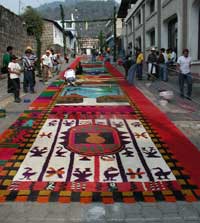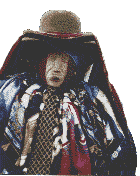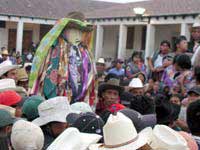 |
|
SantiagoAround the Lake Atitlán Today History Weaving Art Mayan Religion The Cofradias Maximon Semana Santa The Yearly CycleFeria Social Projects Local Business Tienda Santiago Links Photo Archive 2005 Disaster Music Festival Virtual Maximon Light up a candle for the Master!
|
Semana
Santa (Easter week) is by far the most important time of the year for the traditionalist
Atitecos. From the very start, when the friars first introduced the stories
about Jesus being sacrificed for the good of the people by being hung on the
tree of life, they took to the story and started to adapt it to fit into the
Mayan vision of the universe. Semana Santa became the
On Palm Saturday the men do an overnight walk to Chicacao (a village half way to the coast, that used to be part of Tzutujil territory until the conquest) to bring the fruit that they will use to adorn the village. This is a very cosmic walk, as the whole thing is a fertility rite. The men become the "mares" of maximon, and he "rides" them up from the coast along with the very phallic fruit. The fruit will be hung from giant bowers that hoop over the roads all over town and are covered with flowers, greenery, and the fruit brought from Chicacao. On Palm Sunday there is a procession from the convent to the Church at 7 PM and then a late mass. On Monday night Maximons clothes get ritually washed and prepared in a quiet and intimate ceremony by the lakeshore. All day tuesday is dedicated to drying Maximon`s clothes. The cofradias are all in full swing by now, and there is a big celebgation with music and lots of liquor at the Cofradia Santa Cruz. Late at night on tuesday Maximon is assembled and dressed by the telinel and the alcalde of the cofradia that has control of Maximon for the year (they alternate). It is a secret ceremony that has unfortunately become too popular among the Anthropologists and tourists. On wednesday at 10 AM they unpack and present the fruit in front of the municipal building. This is important because, if the fruit was well chosen and the intentions of the men who carried it was good, the fruit will be fresh and perfect. If the fruit emerges bruised or rotten it is a very bad augury for the village. There is a marimba and, in the afternoon, Maximon makes a visit to the mayors office, where he is installed on a tule mat (the Mayan symbol of power) for a couple of hours while the mayor and his advisors render him honor.Then he is taken to his chapel at the side of the church and hung up on a pole. At one point in time, Maximon hung inside the church next to Jesus (they are after all, sacred brothers). When the catholic priests found out about this and they made the traditionalists remove him from the church, they set him up on the side of the doorway to the church. The catholics finally compromised and gave him a chapel on the church square, where he lives today. |
On thursday people visit with Maximon all
day in his chapel, On friday, undoubtedly the most important day of Semana Santa, the day stars early with the adornment of the Señor Sepultado. The mayan concept of sacrifice comes into full play today, as everyone must give themselves to this day in order for the universe to continue working. Jesus is taken down from the cross and placed into an enormous glass casket with much ceremony. He is acompanied at all times by the rain prayer, a special man who has dedicated his life to crying for Jesus while he`s on the cross. This is a very important personage in Santiago, and a special boy is chosen to dedicate his life to this charge. He must be unwed and live from the offerings of the townspeople. When all is ready, a bunch of men line up on both sides of the coffin, pick it up, and start an interesting walk where they take 3 steps forwards and two backwards, swaying all the time back and forth and constantly looking like they are going to drop the casket. The minor saints (Maria Delores and Juan Carajo) line up behind the coffin.This procession will go on all night long, and will travel slowly to the four corners of the universe, represented in Atitlan by four shrines. Along the procession route the people spend hours making sacred pictures on the ground with flowers and colored sawdust all along the route. When the procession walks by, the art is all swept away in another sacrificial demonstration. People in the cofradias are drinking a lot, and there are two or three different marimba bands playing at once around town. There are firecrackers and mortars going off constantly, announcing some other ceremony at some other cofradia. The whole thing unfolds beautifully, each sector doing their part.
On Saturday not much goes on, although this is the day that the patron saint (Santiago) is brought from his cofradia to the church at about 3 PM. On sunday, Maximon leaves the church again to take up his residence in the cofradia. There is not very much about the ressurection in the mayan easter story. |



 replacement for the "dead
days", the extra days introduced into the mayan calender in order to keep it
in tune with the natural cycles. These were non days, where magic roamed free
and the spirits were given full reign. For the traditionalists Semana Santa
is the time where god sky (Jesucristo nahual) has been sacrificed and his twin
brother god earth, the Rilaj Mam, or
replacement for the "dead
days", the extra days introduced into the mayan calender in order to keep it
in tune with the natural cycles. These were non days, where magic roamed free
and the spirits were given full reign. For the traditionalists Semana Santa
is the time where god sky (Jesucristo nahual) has been sacrificed and his twin
brother god earth, the Rilaj Mam, or  All of the many religious organizations are very busy during Easter week,
each performing their own small part of the great performance. There is a
logic and order to it all that only ancient tradition can establish. Here
is a very incomplete schedule of the traditional Semana Santa happenings.This
doesn't include any of the traditional catholic ceremonies.:
All of the many religious organizations are very busy during Easter week,
each performing their own small part of the great performance. There is a
logic and order to it all that only ancient tradition can establish. Here
is a very incomplete schedule of the traditional Semana Santa happenings.This
doesn't include any of the traditional catholic ceremonies.: bearing gifts, visiting the cofradia, making penance,
asking for favors, etc. There is a midnight procession with Jesus, Maria
Dolores, and San Juan Carajo. After the procession there is a very mayan
ceremony where the young men pick up San Juan Carajo (Saint John the Dick)
and run with him back and forth between the church and where they have Maria
Dolores (who is San
bearing gifts, visiting the cofradia, making penance,
asking for favors, etc. There is a midnight procession with Jesus, Maria
Dolores, and San Juan Carajo. After the procession there is a very mayan
ceremony where the young men pick up San Juan Carajo (Saint John the Dick)
and run with him back and forth between the church and where they have Maria
Dolores (who is San Juans concubine.) Whenever the statue gets close to Maria
the young men let out a loud hoot and start pumping the San Juan statue up
and down into the air.... very sexy. This is all part of the fertility and
rainmaking magic that is being worked on at this time of the year.
Juans concubine.) Whenever the statue gets close to Maria
the young men let out a loud hoot and start pumping the San Juan statue up
and down into the air.... very sexy. This is all part of the fertility and
rainmaking magic that is being worked on at this time of the year.  After a long and painful afternoon in the hot sun, at about 4 PM, when
the time is right and the crowd has tranced out from the long afternoon,
Maxomon makes his grand appearance riding on the shoulders of the current
years Telinel. This is a very special charge, as not everybody is "Ajcun"
(shaman) enough to be able to stand the weight of the Grandfather of all.
A lot of care goes into the choosing of the Telinel each year. Maximon basically
comes out of his little chapel and steals the show. Every eye in the square
is on him, and everyone is very curious as to how well the telinel dances
the Maximon bundle. A magical telinel will dance up a storm and can dance
for hours. Most dance until they reach the procession, dance around the other
characters in the passion play a bit, and then runs off to the cofradia,
where Maximon is set up in splendor among the other bundles and statues of
the cofradia. They party for the next week.
After a long and painful afternoon in the hot sun, at about 4 PM, when
the time is right and the crowd has tranced out from the long afternoon,
Maxomon makes his grand appearance riding on the shoulders of the current
years Telinel. This is a very special charge, as not everybody is "Ajcun"
(shaman) enough to be able to stand the weight of the Grandfather of all.
A lot of care goes into the choosing of the Telinel each year. Maximon basically
comes out of his little chapel and steals the show. Every eye in the square
is on him, and everyone is very curious as to how well the telinel dances
the Maximon bundle. A magical telinel will dance up a storm and can dance
for hours. Most dance until they reach the procession, dance around the other
characters in the passion play a bit, and then runs off to the cofradia,
where Maximon is set up in splendor among the other bundles and statues of
the cofradia. They party for the next week. The procession with Jesus' casket continues on its way all night on its
way to the four corners of the universe.
The procession with Jesus' casket continues on its way all night on its
way to the four corners of the universe.